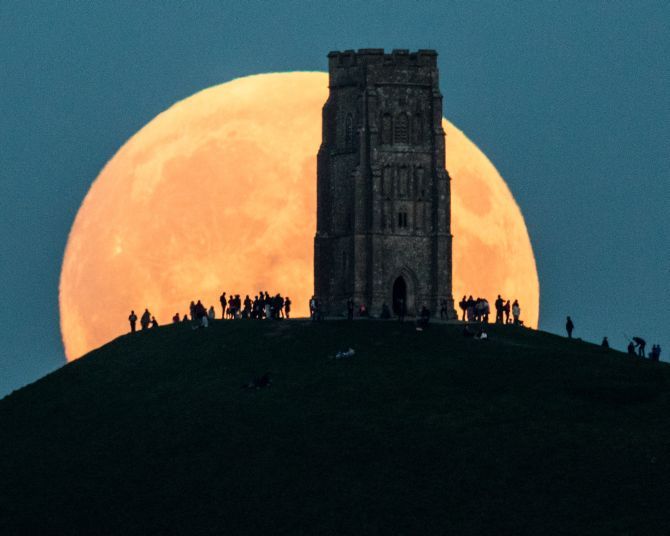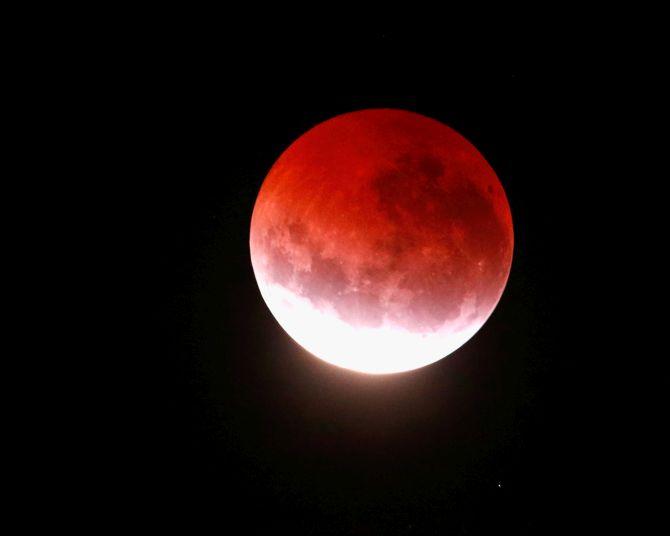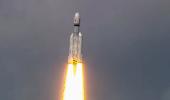Deciphering its secrets will unlock the early history of not only our planet, but also of the star system, explains Kumar Abishek.

We are all moonstruck with the launch of Chandrayaan-3 -- India's latest attempt to demonstrate its capability of safely landing and operating a rover on the lunar surface, becoming only the fourth country to achieve this feat.
Do not let the excitement fade as this 42-day journey is part of a voyage that may eventually lead to the setting up of bases on the moon for astronauts, propelling our efforts to explore places like Mars and beyond.
As lander Vikram and rover Pragyan embark on another mission to unravel the mysteries of the lunar surface, let's scroll through cultures, history and folklore to see perspectives that have shrouded our Chanda mama in mystery.
The first such folklore I was told as a child related to a lonely, old woman who lives all by herself on the moon, observing us earthlings from above.
The woman (or craters) is indeed old -- anywhere between 4.1 billion and 3.9 billion years.

Before we dive deeper into the cultural history of the moon, let's decode its etymology.
The word 'moon' can be traced back to 'mona', an Old English word said to have been derived from the Proto-Germanic'menon', which shared its roots with the Sanskrit masah -- both derived from the Proto-Indo-European 'menses' or 'month'(me means to measure, in reference to lunar phases as an ancient and universal measure of time).
On the other hand, chandrá in Sanskrit traces its roots to (s)kand or scandrá in Proto-Indo-European.
The word meant 'shining' or 'radiant' -- adjectives that are fit to describe Luna, the Roman moon goddess.

This was the first time in three decades that a supermoon -- the time when the moon is at its closest orbit to the Earth, making it appear around 14 per cent bigger -- combined with a lunar eclipse, giving the moon an ethereal red glow.
You won't get to see this sight till 2033. Photograph: Matt Cardy/Getty Images from the Rediff Archives
To fairly illustrate humanity's relationship with the moon is an unattainable task.
The moon's earliest meanings for us were spiritual and often sacred: A faraway, mysterious object that was radiant in the darkness of the night; it had phases which affected tides.
In fact, lunar phases were a timekeeping tool, and the periods of its waxing and waning were the basis of many calendars.
In what could be the oldest lunar calendar ever created, the 15,000-year-old paintings on the walls of prehistoric caves at Lascaux in France, according to Michael Rappenglueck of the University of Munich, depict the moon going through its phases.

The Pink Supermoon is an astronomical event that occurs when the moon is closest to the Earth in its orbit, making it appear much larger and brighter than usual. Photograph: Dylan Martinez/Reuters
Though lunar deities were only a few across cultures, they were often characterised as dangerous male figures among hunter-gatherers and as benevolent women in later agricultural traditions.
For the Vedic people, who deified the moon as Soma/Chandra, the celestial body represented recurrence, rebirth, decay, and impermanence.
For ancient Egyptians, the moon god Khonsu, whose name meant traveller, was generally depicted as a youth.
The Mayans told stories about the moon goddess, Ix Chel, and how she fell in love with the mercurial sun god, and then came out of the abusive relationship.

Now, let's move to the world of science fiction.
The first written imagination of a voyage to the moon can be attributed to Church of England bishop Francis Godwin, who wrote The Man in the Moone in the 1620s.
It tells the story of Spanish citizen Domingo Gonsales, who after having been stuck at St Helena uses the power of wild swans in his bid to return home but ultimately lands on the moon, where he meets inhabitants -- the Lunars -- who he describes as Christian people enjoying life in a pastoral utopia.
H G Wells' The First Men in the Moon (1901) talks about the adventures of earthlings Bedford and Cavor as they encounter insectoid 'selenites', 'mooncalves', and extraordinarily rapidly growing plants on the lunar surface.
Among movies, we witnessed the Varun Dhawan-starrer Bhediya only last year and the impact of the new moon on 'werewolves'.
The moon is now part of a new political and commercial reality. Hence, its mysteries, too, now should have roots in reality, rather than in human imagination.

While the lander and rover of Chandrayaan-3 would seek to 'measure the near-surface plasma (ions and electrons) density' and carry out qualitative and quantitative elemental analysis of the lunar surface, besides other tasks, there are still several unanswered questions about Earth's only natural satellite.
Some of these are: Is the Earth-Theia (a Mars-sized early planet) collision theory for the birth of the moon nearly 4.5 billion years ago wrong?
Is there enough water on the lunar surface to support long-term human missions?
What can it tell us about the development of life on Earth?
Why is the far side of the moon so different from the one we can see -- it has a thicker crust and hardly any large lava sea or maria that we see on the near side?
The moon is something like the mysterious Rosetta Stone of our solar system and deciphering its secrets will unlock the early history of not only our planet, but also of the star system.
Also, it will remain lovely as ever for the romantics, even as we shoot for the moon and revel in our scientific curiosity.
Feature Presentation: Ashish Narsale/Rediff.com











